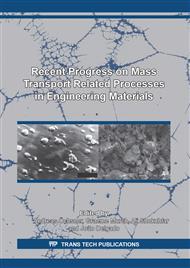[1]
W.D. Callister Jr., D.G. Rethwisch, Fundamentals of materials science and engineering: an integrated approach. 3rd. ed., John Wiley & Sons, Inc., New York, USA (2008).
Google Scholar
[2]
W.D. Callister, Jr., Materials science and engineering: an introduction. 7th ed., John Wiley & Sons, Inc., New York, USA (2007).
Google Scholar
[3]
D.A. Brosnan, G. C. Robinson, Introduction to drying of ceramics. The American Ceramic Society, Ohio (2003).
Google Scholar
[4]
M. Hasatani, Y. Itaya, Modeling of strain-stress behavior for advanced drying. In: International Drying Symposium (Drying'96), Krakow, Poland, A (1996) 27-39.
Google Scholar
[5]
Y. Itaya, M. Hasatani, R & D needs-drying ceramics, Drying Technol. 14(6) (1996) 1301-1313.
DOI: 10.1080/07373939608917147
Google Scholar
[6]
J.S. Reed, Principles of ceramics processing, John Wiley & Sons, Inc., New York, (1995).
Google Scholar
[7]
A. Sander, D. Skanki, B. Nenad, Heat and mass transfer models in convective drying of clay slabs, Ceramics Inter. 29 (2003) 641- 643.
DOI: 10.1016/s0272-8842(02)00212-2
Google Scholar
[8]
J.J.S. Nascimento, A.G.B. Lima, B.J. Teruel, F.A. Belo, Heat and mass transfer with shrinkage during the ceramic bricks drying. Información Tecnológica 17(6) (2006) 125-132. (In Spanish).
Google Scholar
[9]
J.B. Silva, G.S. Almeida, W.C.P.B. Lima, G.A. Neves, A.G.B. Lima, Heat and mass diffusion including shrinkage and hygrothermal stress during drying of holed ceramics bricks, Def. Diff. Forum 312-315 (2011) 971-976.
DOI: 10.4028/www.scientific.net/ddf.312-315.971
Google Scholar
[10]
W.P. Silva, V.S.O. Farias, G.A. Neves, A.G.B. Lima, Modeling of water transport in roof tiles by removal of moisture at isothermal conditions, Heat Mass Transf. 48(5) (2012) 809–821.
DOI: 10.1007/s00231-011-0931-4
Google Scholar
[11]
G.S. Almeida, M.A.F. B. Fernandes, J.N. F. Fernandes, G. A. Neves, W.M.P. B. Lima, A.G.B. Lima, Drying of industrial ceramic bricks: An experimental investigation in oven. Def. Diff. Forum 353 (2014) 116-120.
DOI: 10.4028/www.scientific.net/ddf.353.116
Google Scholar
[12]
G.S. Almeida, J.B. Silva, C.J. Silva, R. Swarnakar, G.A. Neves, A.G.B. Lima, Heat and mass transport in an industrial tunnel dryer: Modeling and simulation applied to hollow bricks, Appl. Thermal Eng. 55(1–2) (2013) 78-86.
DOI: 10.1016/j.applthermaleng.2013.02.042
Google Scholar
[13]
J.B. Silva, Simulation and experimentation of the drying of hollow ceramic bricks. Doctoral Thesis in Process Engineering, Federal University of Campina Grande, Campina Grande, Brazil 174 (2009). (In Portuguese).
DOI: 10.21475/ajcs.2016.10.10.p7455
Google Scholar


